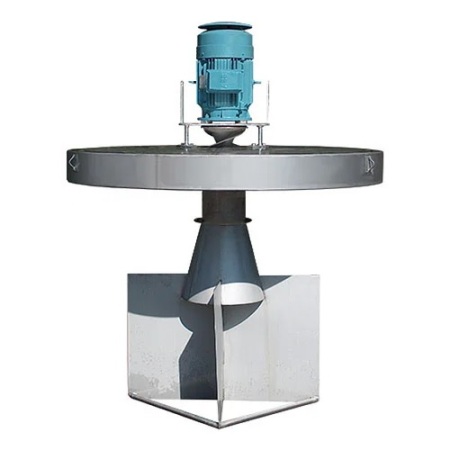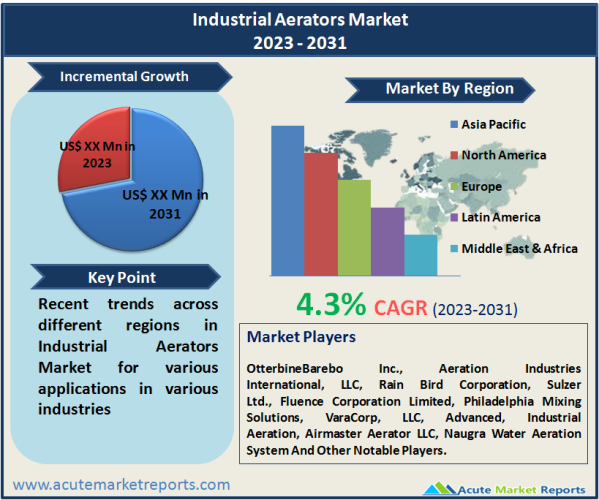
The industrial aerators market plays a pivotal role in various industrial processes by facilitating efficient oxygen transfer and mixing of liquids. These essential devices find application in diverse industries, including wastewater treatment, aquaculture, and chemical processing. In this comprehensive analysis, we delve into the market's key drivers, a significant restraint, market segmentation, geographic trends, and competitive strategies that shape this vital sector. The industrial aerators market is expected to grow at a CAGR of 4.3% during the forecast period of 2025 to 2033, driven by sustainability requirements in wastewater treatment, the growth of aquaculture, and the expansion of chemical and pharmaceutical manufacturing.

Environmental Regulations and Sustainability Initiatives
Environmental regulations and sustainability initiatives have emerged as major drivers of the industrial aerators market. Governments worldwide have implemented stringent environmental regulations to combat pollution and promote sustainable practices in industries. These regulations have forced industrial facilities to adopt advanced wastewater treatment solutions, including industrial aerators, to comply with discharge limits and reduce their environmental footprint. For instance, in 2024, several countries enforced stricter effluent quality standards, which compelled industries to upgrade their wastewater treatment infrastructure. This trend is expected to continue, with further tightening of regulations in the forecast period.
Additionally, corporate sustainability initiatives and growing public awareness about environmental conservation have encouraged businesses to invest in cleaner technologies. Many companies are now voluntarily implementing eco-friendly practices, such as efficient aeration systems, to reduce their carbon footprint. This shift toward sustainability is anticipated to drive the demand for industrial aerators as companies seek to align with global environmental goals.
Rapid Industrialization and Urbanization
The rapid pace of industrialization and urbanization in emerging economies is another significant driver of the industrial aerators market. As these countries experience robust economic growth, the expansion of industries and urban areas leads to increased wastewater generation. Industrial facilities, municipalities, and wastewater treatment plants require efficient aeration systems to manage and treat this wastewater effectively. Furthermore, population growth in urban areas increases the demand for clean water, spurring investments in water and wastewater infrastructure. This, in turn, drives the adoption of industrial aerators for wastewater treatment and aeration in treatment facilities. The expected urbanization trends in regions like Asia-Pacific, Latin America, and Africa are likely to fuel the demand for industrial aerators during the forecast period.
Technological Advancements in Aeration Systems
Technological advancements in aeration systems have been pivotal in propelling the industrial aerators market forward. Innovations in aerator design, materials, and monitoring systems have led to more energy-efficient and cost-effective solutions. For instance, the development of high-efficiency diffused aeration systems and the integration of smart sensors for real-time monitoring and control have enhanced the performance of industrial aerators. These technological advancements not only improve the efficiency of wastewater treatment processes but also reduce operational costs for industries and municipalities. As organizations seek ways to optimize their processes and reduce energy consumption, the adoption of advanced industrial aerators becomes an attractive option. This trend is expected to continue, with manufacturers investing in research and development to further improve aeration system performance.
High Initial Investment Costs
Despite the numerous advantages of industrial aerators, one of the key restraints in the market is the high initial investment required for the purchase and installation of these systems. Industrial aerators come in various types, such as surface aerators, diffused aerators, and mechanical aerators, each catering to specific needs and conditions. Depending on the type and size of the aeration system needed, the upfront capital expenditure can be substantial. Additionally, the costs associated with infrastructure modifications, electrical connections, and maintenance further contribute to the overall investment. Small and medium-sized enterprises (SMEs) and resource-constrained municipalities may find it challenging to allocate the necessary funds for such systems. However, it's worth noting that the long-term benefits, including reduced operational costs and compliance with regulations, often outweigh the initial expenses, making it a strategic investment.
Continuous Stirred-tank Reactor (CSTR) Dominates Market by Type
In 2024, the segment that has held the highest revenue by type in the industrial aerators market is the Continuous Stirred-tank Reactor (CSTR) segment. Continuous Stirred-tank Reactors are widely used in various industries for their versatility and efficiency in promoting chemical reactions and wastewater treatment processes. Their adaptability and effectiveness in handling different types of reactions and effluents make them a preferred choice, driving their demand and resulting in the highest revenue within the industrial aerators market.
Metal Dominates the Market by Material
In the industrial aerators market, the segment that has held the highest revenue by material is the “metal" segment, in 2024. Metal-based industrial aerators, often constructed from materials such as stainless steel or cast iron, have consistently generated the highest revenue due to their durability, resistance to corrosion, and suitability for use in harsh industrial environments. These qualities make metal-based aerators a preferred choice in various industries, including chemical processing, food and beverage production, and wastewater treatment, where they are exposed to aggressive chemicals and demanding conditions. Consequently, the Metal segment has maintained its position as the leader in revenue generation within the industrial aerators market.
North America Remains Global Leader
North America has consistently maintained its position as the region with the highest revenue percentage in the industrial aerators market. This dominance can be attributed to several key factors that collectively contribute to the region's strong performance in this sector. First and foremost, North America boasts a diverse range of well-established industries, including manufacturing, chemical processing, food and beverage production, and more. These industrial sectors generate substantial amounts of wastewater, necessitating efficient and effective wastewater treatment solutions. Consequently, the demand for industrial aerators remains consistently high in this region. Furthermore, North America benefits from a mature wastewater treatment infrastructure. Many wastewater treatment facilities across the United States and Canada have been operational for decades. To meet evolving environmental standards and regulations, these facilities continually invest in upgrading and modernizing their infrastructure. As a result, there is a continuous need for advanced aeration systems to optimize wastewater treatment processes. Stringent environmental regulations also play a pivotal role in driving the demand for industrial aerators in North America. The United States and Canada, in particular, have some of the most rigorous environmental regulations globally. These regulations impose strict effluent quality standards and emission limits on industrial and municipal wastewater discharges. To achieve compliance, industries and municipalities invest in high-quality industrial aerators to ensure their wastewater treatment processes meet these stringent requirements.
Competitive Trends
The industrial aerators market features several key players who employ various strategies to maintain their market presence. These strategies include product innovation, strategic partnerships, and expansion into emerging markets. Companies often focus on energy-efficient aerator designs and customization to meet specific industry needs.In conclusion, the Industrial Aerators Market is driven by sustainability requirements in wastewater treatment, the growth of aquaculture, and the expansion of chemical and pharmaceutical manufacturing. However, energy consumption and operational costs present a notable restraint. Market segmentation by type and material reflects the diverse applications of industrial aerators, while geographic trends highlight regions with substantial market potential. Competitive strategies focus on innovation and expansion, ensuring that the market evolves to meet the needs of diverse industries in the forecast period from 2025 to 2033.
Historical & Forecast Period
This study report represents analysis of each segment from 2023 to 2033 considering 2024 as the base year. Compounded Annual Growth Rate (CAGR) for each of the respective segments estimated for the forecast period of 2025 to 2033.
The current report comprises of quantitative market estimations for each micro market for every geographical region and qualitative market analysis such as micro and macro environment analysis, market trends, competitive intelligence, segment analysis, porters five force model, top winning strategies, top investment markets, emerging trends and technological analysis, case studies, strategic conclusions and recommendations and other key market insights.
Research Methodology
The complete research study was conducted in three phases, namely: secondary research, primary research, and expert panel review. key data point that enables the estimation of Industrial Aerators market are as follows:
Market forecast was performed through proprietary software that analyzes various qualitative and quantitative factors. Growth rate and CAGR were estimated through intensive secondary and primary research. Data triangulation across various data points provides accuracy across various analyzed market segments in the report. Application of both top down and bottom-up approach for validation of market estimation assures logical, methodical and mathematical consistency of the quantitative data.
| ATTRIBUTE | DETAILS |
|---|---|
| Research Period | 2023-2033 |
| Base Year | 2024 |
| Forecast Period | 2025-2033 |
| Historical Year | 2023 |
| Unit | USD Million |
| Segmentation | |
Type
| |
Material
| |
Automation
| |
Operation
| |
End-Use
| |
Distribution Channel
| |
|
Region Segment (2023-2033; US$ Million)
|
Key questions answered in this report